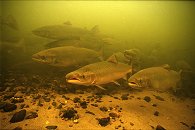The Salmon Life cycle
 The
Atlantic Salmon begins its life when spawning occurs in scooped
out hollows on a gravel bed on a stream. The eggs that are produced
take around 70 to 200 days to hatch. The newly born young or alevin
have a yolk-sac attached which will provide food for one and a
half months. Whilst the Atlantic salmon is born in freshwater
it will spend most of its life at sea. Only returning to the river
from whence it came to spawn. That is if it can survive the many
life threatening obstructions it will meet along the way.
The
Atlantic Salmon begins its life when spawning occurs in scooped
out hollows on a gravel bed on a stream. The eggs that are produced
take around 70 to 200 days to hatch. The newly born young or alevin
have a yolk-sac attached which will provide food for one and a
half months. Whilst the Atlantic salmon is born in freshwater
it will spend most of its life at sea. Only returning to the river
from whence it came to spawn. That is if it can survive the many
life threatening obstructions it will meet along the way.
Whilst at sea the Atlantic salmon travel
widely some making transatlantic migrations to feeding grounds
off Greenland or in the Norwegian sea. Unfortunately Due to highly
technically equipped fishing vessels a lot of these feeding grounds
have been discovered and have been over fished contributing to
the decrease in the salmon population in our seas. After approximately
3 or 4 years at sea the salmon will attempt to return to the upper
reaches of its parent river to spawn. If it can elude the estuary
nets, seals, poachers and the river fishermen it may just succeed.
Once the salmon have spawned the life cycle begins all over again.
However the largest percentage of salmon that have spawned will
die and only a very small percentage of salmon will make it back
to the sea for a second time.
 The
Atlantic Salmon begins its life when spawning occurs in scooped
out hollows on a gravel bed on a stream. The eggs that are produced
take around 70 to 200 days to hatch. The newly born young or alevin
have a yolk-sac attached which will provide food for one and a
half months. Whilst the Atlantic salmon is born in freshwater
it will spend most of its life at sea. Only returning to the river
from whence it came to spawn. That is if it can survive the many
life threatening obstructions it will meet along the way.
The
Atlantic Salmon begins its life when spawning occurs in scooped
out hollows on a gravel bed on a stream. The eggs that are produced
take around 70 to 200 days to hatch. The newly born young or alevin
have a yolk-sac attached which will provide food for one and a
half months. Whilst the Atlantic salmon is born in freshwater
it will spend most of its life at sea. Only returning to the river
from whence it came to spawn. That is if it can survive the many
life threatening obstructions it will meet along the way.